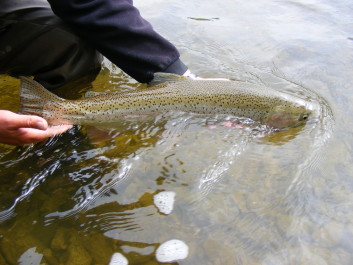One of the more misunderstood areas of fly-fishing for trout is rise forms and their relation to fly selection. A trial and error method works well if there are no tell tale signs of the trout’s feeding activity. But what about those days when bugs are hatching and fish are working the surface? You can identify the insect, you have a good match and let’s assume your approach is stealthy and you have not spooked the fish. Let’s also assume that your presentation is adequate and you feel confident. You find your target fish, make an accurate cast and the fish moves under the fly, drops back with it and returns to it’s feeding lane. A classic refusal and no matter how often it happens, it still leaves you scratching your head.
This is why identifying rise forms becomes critical. Many things happen during a hatch and they can all affect how the trout react. Some flies sit on the water longer than others and take longer to dry their wings. This may be due to colder than normal air temperature or it’s simply the nature of the insect. For example, blue winged olives will drift for many yards before getting aloft, where light Cahill’s may drift only for a few feet. Cold weather may also cause an unnatural number of stillborns or cripples. Often you may find two or more insects hatching at once. A spinner fall may occur during an emergence or at its tail end causing the fish to change their feeding rhythm. These factors and more will affect how the fish feed and what rises will look like. Recognizing these differences will make you more successful.
Lets look at a hatch and its relationship to rise forms. There are four practical stages to an emergence. When the time is right, the nymphs break away from their homes in the substrate and get caught in the current. They drift helplessly for the most part on their way to the surface and are at the mercy of the river. Most nymphs at this point start to go through a change. Their nymphyl shuck starts to separate from the body and through respiration; they develop a thin layer of air between the shuck in the wing case. This bit of air trapped in the wing case makes the nymph buoyant and accelerates its accent. Once on the surface, it breaks through the wing case and desperately wiggles out of the shuck. For all intents and purposes, this is what we label “emergers”. Once completely out of the shuck and exposed to the air, the wings start to dry and the dun is ready to fly. Those that don’t get eaten or die of natural causes, fly to the trees, go through one more shedding, mate and return as spinners.
In the females case, lay her eggs and the males case, simply die. In both sexes though, their fate is pre-determined.
Mayflies and caddis flies differ slightly at each stage but the life cycles and their relationship with rise forms are close and need to be understood in order to fully appreciate how critical they are to greater success. Tomorrow we will look at where all of this is relevant to catching more trout.

